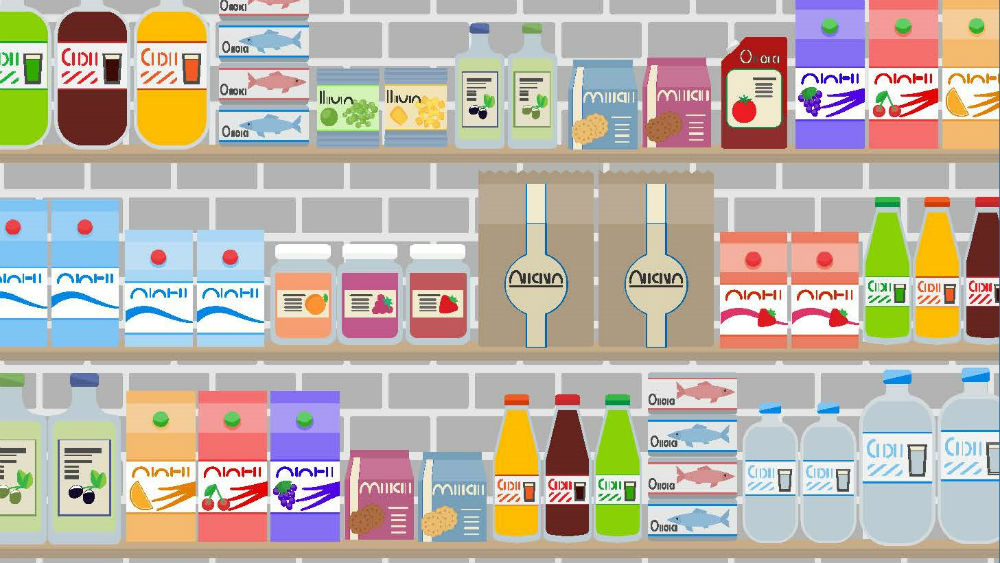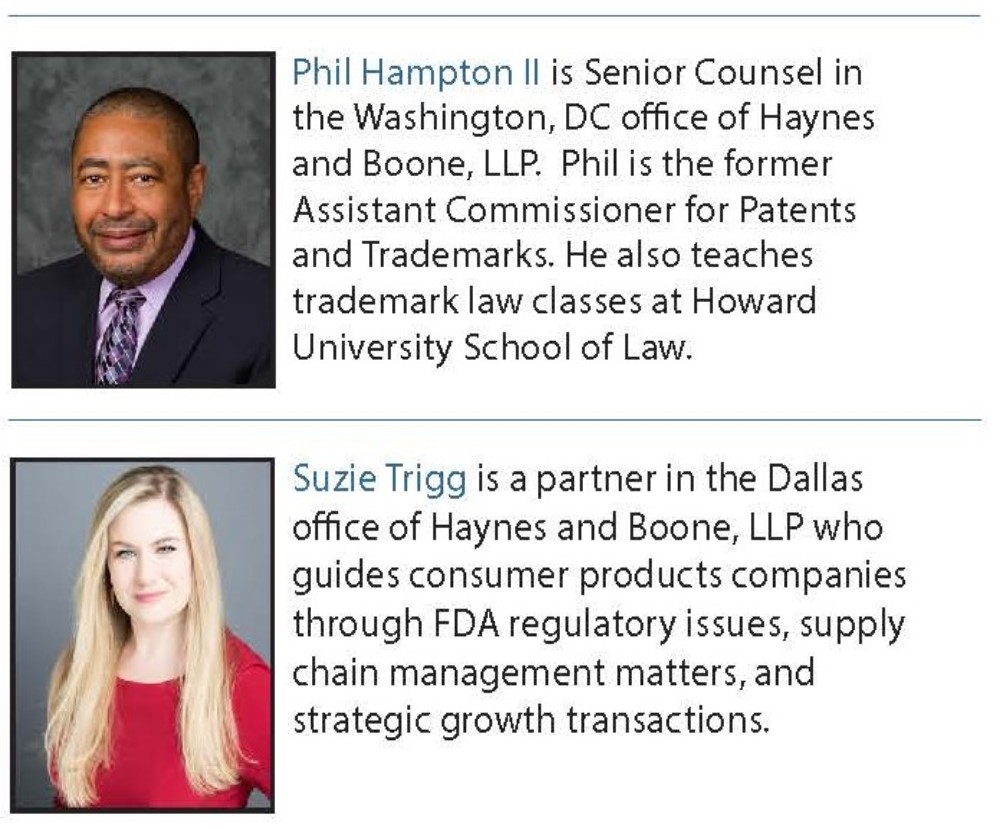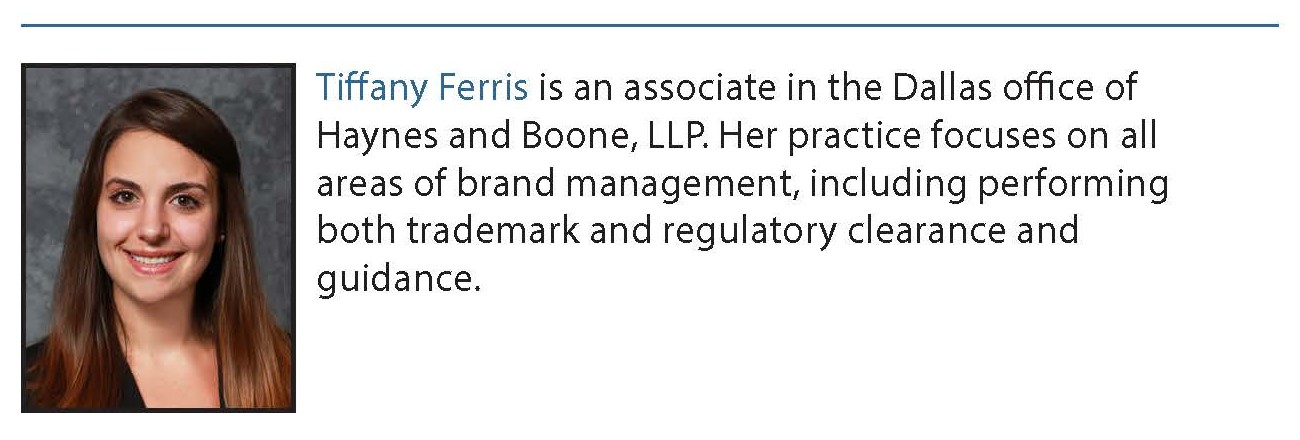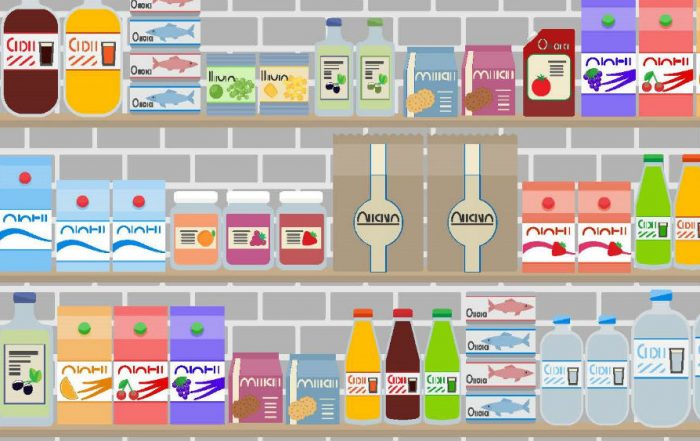
What’s in a Name? Sometimes, a Claim
Why Marketers Need Trademark and Regulatory Counsel at the Naming Stage
by Suzie Trigg, Phil Hampton II, and Tiffany Ferris
Savvy marketers know that a product name is important. It is part of what sets your product apart from a host of others on the market. In “trademark speak,” it is your source identifier.

Perhaps because they are so important, product names often undergo “clearance” by trademark counsel, who analyze the name’s suitability as a source identifier vis-à-vis third parties and the United States Patent and Trademark Office (USPTO). A “clear” name might next undergo prosecution in an attempt to obtain a federal registration. This clearance and prosecution process often happens without any input from regulatory counsel. This approach is both problematic and costly. Product names can be more than source identifiers. They can and often do make claims about a product’s attributes. Such claims may make marketers the target of enforcement actions from federal agencies like the Food and Drug Administration (FDA).
While clearance and prosecution are important steps in the branding process, trademark issues should not be the only considerations at the naming stage. Product names need to be more than cleared and applied for—they need to be reviewed from regulatory and false advertising risk perspectives. In our experience as outside counsel, many companies choose to undertake these types of assessments after the trademark name has been established (or, sometimes, not at all). Early consideration of these concerns, especially with respect to FDA regulations, can help mitigate the risk of enforcement action, avoid costly rebranding activities, and help set the stage for lower risk promotion of products. Regulatory counsel should be involved in the naming process, and marketing departments should consult regulatory counsel, simultaneously or before, trademark counsel.
How a Product Name Becomes a Product Claim
own its ruling in Pom Wonderful LLC v. Coca-Cola Co., and marketers of products regulated under the Federal Food, Drug, and Cosmetic Act (FDCA) learned that compliance with FDCA regulations does not prohibit suits under the Lanham Act based on misleading and deceptive labels and names. While the notoriety of this case may draw attention, marketers should remember that the inverse of this holding is also true. False or misleading names, even those that function as trademarks and/or obtain federal registrations, may more often be challenged by FDA.
Under the FDCA, a food product is considered misbranded if the labeling is false or misleading in any material respect, or if it purports to be a defined and standard food, but fails to actually comply with the definition and standard. A product name, as part of a food’s label, can be false or misleading under the FDCA, regardless of whether it would be considered so under the Lanham Act. For example:
JUST MAYO — In 2015, Hampton Creek, Inc. obtained a federal registration for the mark JUST MAYO covering “vegetable-based spreads” and “egg- and dairy-free mayonnaise; salad dressing.” In order to receive its registration, Hampton Creek had to disclaim the term “MAYO”—i.e., Hampton Creek stated on the record that it did not have the exclusive right to use “MAYO” apart from the mark JUST MAYO. The Trademark Office required the disclaimer since it believed “MAYO” was an abbreviation for “mayonnaise,” to be descriptive of the vegetable-based spreads and egg- and dairy-free mayonnaise for which the registration was sought. A week after it received its trademark registration, Hampton Creek received a warning letter from FDA stating that JUST MAYO was misbranded in part because it “purports to be standardized food mayonnaise due to the misleading name and imagery used on the label, but it does not qualify as standardized food mayonnaise.” The letter explained that the term “JUST” together with “MAYO” reinforced the idea that the product is real mayonnaise because it suggests that the product is “all mayonnaise” or “nothing but” mayonnaise. FDA, then, took an opposite view from the Trademark Office: while the latter found “MAYO” to describe the product, the former found the name to be misleading. Neither decision had any bearing on the other.
MUSCLE MILK — Cytosport, Inc. received its first trademark registration for MUSCLE MILK, covering “powdered nutritional supplement containing milk derived ingredients for adding to food or drink in 2000. More than a decade later, in 2011, FDA sent Cytosport a warning letter, explaining that the MUSCLE MILK name could be misleading to consumers since the product does not contain milk. The MUSCLE MILK name from a trademark perspective is fine—it is not deceptively mis-descriptive of the product, and it is arguably not descriptive since the product sold under it is not milk. Thus, the very thing that enabled Cytosport to register its name without having to disclaim the term “MILK” is part of what spurred FDA to take action.
BETTER’N PEANUT BUTTER — Wonder Natural Foods Corporation received its trademark registration for BETTERN’N PEANUT BUTTER in 1998. In 2015, FDA issued a warning letter declaring the product as misbranded, in part, because the product purports to be “peanut butter” but does not qualify as “peanut butter” under applicable regulations. Again, a trademark lens would and did consider the “PEANUT BUTTER” portion of the name to be descriptive.
ALMONDMILK — In 2012, JEC Consulting and Trading, Inc. filed a trademark application for the name ALMONDMILK covering “almond-based food and beverage as a milk substitute.” The Trademark Office refused to register the name, considering it merely descriptive of those products. Applicable federal regulations describe milk as the “lacteal secretion . . . obtained by the complete milking of one or more healthy cows.” FDA has not yet issued its specific guidance on “faux” milks—those milk-like products that are derived from non-dairy sources like soy or various nuts. Collaboration between regulatory and trademark attorneys regarding faux milk names may lead to decisions not to prosecute trademark applications. From a regulatory perspective, there is a significant chance that FDA will take steps to stop the use of the word “milk” in connection with anything that is not a true dairy product. From a trademark perspective, the terms “almond milk,” “soy milk,” and others are almost certainly to be considered descriptive matter. Thus, both regulatory and trademark concerns may lead to a decision not to expend resources on attempts to obtain a trademark registration.
Names can also run afoul of the FDCA by making a claim that the product is intended to diagnose, cure, mitigate, treat, or prevent disease or to affect the structure or function of the body. Products that make such claims are considered drugs under the FDCA and must comply with drug regulations. Examples of names used in this capacity include:
NICO WATER — In 2001, a company named Kessler & Associates filed a trademark application for the mark NICO WATER covering “drinking water containing Nicotine supplementation.” The application claimed that the mark was first used in United States commerce as early as June 2001—meaning that Kessler & Associates declared that the mark had been placed on products that were sold or transported in interstate commerce regulated by Congress as early as 2001. In 2002, FDA declared that bottled water containing nicotine is an unapproved drug that cannot be sold in the United States without federal clearance. Two years after FDA’s decision, the trademark application matured into registration and was assigned to the purveyor of the NICO WATER product, Quick Test 5. While this example may be complicated by the trademark registration’s changes in ownership, it is a prime example of why regulatory and trademark counsel should at the very least work together from the earliest naming stages. The trademark application claimed use in commerce back to 2001, but Quick Test 5 said in 2002 that it had not shipped any cases of water. These conflicting statements opened the trademark owners to the risk that a claim for Fraud on the Trademark Office could be brought, and that the mark could be cancelled. Moreover, there were indications of a potential regulatory issue back in 2001, when anti-tobacco groups stepped in to ask FDA to regulate nicotine waters as a drug. Regulatory review at the naming stage may have led to a decision to wait to file a trademark application.
JOINT REPAIR — JW Nutritional LLC received a warning letter in 2015 regarding several of its products. Among the issues raised by FDA was the fact that the product name JOINT REPAIR implies the product is for use in the cure, mitigation, or treatment of a diseased or damaged state. Thus, the product name made a claim that classified it as an unapproved new drug. A trademark view of this name would most likely result in an assessment that the name is probably descriptive of joint supplements, but would likely not alert the marketer to the chances of FDA viewing it as a drug.
PSORIASOOTHE — Moon Valley Natural Products received a warning letter in 2017 regarding several of its products. Among the issues raised by FDA was that the product name PSORIASOOTHE suggests the product is intended to treat psoriasis and thus made a claim that classified it as an unapproved new drug. A trademark analysis would likely conclude the name is not descriptive—as a single term made up by “telescoping” the words “psoriasis” and “soothe,” the mark should escape rejection on descriptiveness grounds.
The Shortcomings of a Trademark-Only Lens: Why Marketers Need Trademark and Regulatory Counsel at the Naming Stage
As the above examples illustrate, neither a competent trademark clearance opinion nor ownership of a federal trademark registration provides a defense against challenges that a product name is false or misleading, especially with respect to FDA. Regulatory attorneys, however, are often not consulted while names are being cleared or applied-for, processes that do little to help spot potential FDA pitfalls.
Trademark clearance itself is unlikely to provide any insight on the implications of a name vis-à-vis FDA. Traditional trademark clearance tends to focus on whether a name is available for use and/or for registration. A trademark attorney performing clearance will typically look to issues like distinctiveness and likelihood of confusion. She is concerned with questions like: “can this name function as a trademark for my client?” “Can she obtain rights in the name?” “Can she protect it with a registration, or enforce it against others?” “Would a third party’s mark stop my client from obtaining a registration, or could that party stop my client’s use?” Questions about whether a product claim is made at all, let alone whether that claim has implications under the FDCA, often are not considered unless or until product labeling or advertising review is completed.
Prosecution of a trademark application may actually lead to a finding that is in conflict with FDA’s assessment (as with JUST MAYO). The complexities of the Lanham Act’s registration framework may be partially to blame for this. The Lanham Act prohibits the registration of marks that are deceptive. A deceptive, and therefore unregisterable, mark is one where:
(1) the mark misdescribes the character, quality, function, composition, or use of the underlying product;
(2) consumers are likely to believe that the misdescription does actually describe the product; and
(3) consumers are likely to rely on that misdescription in making a purchasing decision.
A mark that does not meet all three prongs of this somewhat amorphous test, but that nevertheless is misleading, may be considered “deceptively misdescriptive.” But, the mark can still be registered by showing that the mark is inherently distinctive or that it has obtained secondary meaning to become distinctive in the eyes of the consuming public. Thus, a term that might be viewed as “false” or “misleading” from a regulatory perspective may only have to prove that it has acquired distinctiveness to become a registered trademark.
A trademark-only view of food and drug names and labels is especially unhelpful in assessing risk of action by FDA because the operative definitions and frameworks of the Trademark Office and FDA are different. While the Trademark Office or an attorney conducting trademark clearance might consider a name descriptive of the goods sold under it, the FDCA might consider the name to misbrand a product. Many trademark attorneys are not familiar with these types of granular FDA regulations, and would not consider such an issue at the clearance or prosecution stages. By the time regulatory counsel would see it, likely at the labeling or advertising review stage, money has already been sunk into the clearance and prosecution processes. Addressing both at the beginning of the naming process could save significant time and money, and allow businesses to make more informed decisions.
Unless trademark and regulatory counsel are the same person, marketing teams should involve both at the earliest stages of the naming process. This will help steer early risk analysis in a direction that considers not only trademark issues, but whether the name makes a claim that could be the subject FDA enforcement action and can help lower enforcement risks involved with the promotion of any FDA-regulated product.
Update Magazine
January/February 2018






